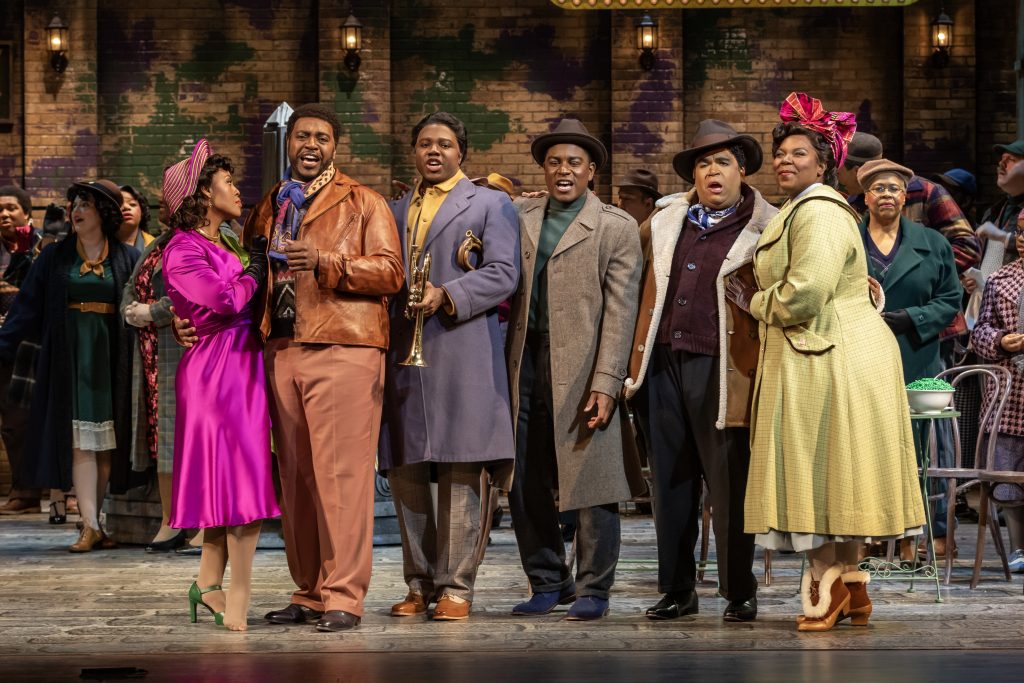Florentine Offers Bronzeville Boheme
Localizing Puccini's 'La Boheme' in Milwaukee's Bronzeville yielded uneven but affecting production.
For several years the Florentine Opera Company had been contemplating creating a “Bronzeville Boheme” – a resetting of the famous Puccini opera La Boheme about impoverished artistic life in 19th century Paris to Milwaukee’s Bronzeville community of the 1940s and early 1950s.
Just as I-43 and other economic changes bulldozed Bronzeville into a fading memory (it was once a majority-Black culture of nightclubs, jazz and neighborly businesses), so did COVID-19 and other tribulations delay the Bronzeville operatic conceit until this past weekend’s production of two shows at the Marcus Center for the Performing Arts, the last ending Sunday afternoon April 21.
You need to borrow the program guide for the production to get the full weight of the Bronzeville personalities and places behind the concept, but there were touches of Milwaukee’s Bronzeville in the production deeper than the Black performers playing all the leads, hardly unusual in today’s opera world.
The show was still named La Boheme as it has been many previous times at the Florentine dating back to the fifties. But there were echoes of Bronzeville in Lawrence E. Moten III’s sets, which gently suggest Black culture, in muralist Ras Ammar Nsoroma’s contributions, in the 1940s coats and other elements of Mieka van der Ploeg’s costumes and the subtler winter effects of Kathy Perkins’ lighting.
The opera is in Italian but had busy supertitles in English above the stage, the four acts equally divided by one intermission (and long pauses for set changes). The opening scene established a freezing garret where poet Rodolfo burns his play to keep warm and Mimi stumbles in looking for a light to her candle. She and Rodolfo establish a gently beautiful flame in a well-done exchange of famous arias.
Just before intermission, there was also a stab made at humanizing the crowded use of children (playing metronomically with toys, unlike what children normally do) and the Florentine chorus as the party moved outside under some Bronzeville-like signage. While well meant in design suggesting the 1940s, it was the weakest sequence with the most famous aria – “Musetta’s Waltz,” which (uncredited to Puccini) became a pop hit for Della Reese in 1959, “Don’t You Know.”
The failures in this scene actually pinpointed the problem. Puccini and the general production are devoted to emphasizing a visceral reality among the starving artists, despite some obvious conventions of grand opera (in Italian while set in Paris). The singers had to find ways to make their stage behavior seem one with the music, not at war with it.
The lovers quarreling amid this outdoor crowd were either too pointed or too muddled in trying to give all the children and group singers a chance while Marcello and Musetta’s flirtation remained the key ingredient. The essential stage business got a bit lost here.
Indeed, the staging stood out negatively in what in most other moments is a sensitive triumph of Puccini’s thrust toward realism within the opera format, an intention much abused over the decades.
Stage director Nadja Simmonds clearly had Bronzeville’s humanistic connections and Puccini’s efforts at realistic counterpoint in mind. She played with this idea even more than Puccini’s music does in exploring the masculine boisterousness against the struggles of the ailing Mimi.
Curiously, the director’s approach made the traditional singing of some famous music less vital to success than the personal contact among the players, which is a direction I’d prefer to see the Florentine go.
For instance, Michelle Johnson as Mimi proved herself a formidable soprano, struggling to find Mimi in acting terms but pinning the back wall of Uihlein Hall with the strength and gentle lyricism of the famous passages. Her singing couldn’t be faulted. But her methods of communicating the frail nature of Mimi didn’t square with the production’s push for believable interaction.
Similarly Kelebogile Besong had scheming fun and lyrical loveliness with Musetta – catching the saucy nature of the part in the more traditional vein of opera acting.
Director Simmonds was more explorative in the tableaus and interaction of the male leads. Sometimes they were too uselessly busy, but overall, they captured the spirit of struggling artists who indulge their emotions.
Chaz’men Williams-Ali caught all the soulful big notes of poet Rodolfo but his acting was more boyish, daring and mischievous than is usually the case. It provided a nice contrast to Rodolfo’s anguished high note concerns for Mimi. But it made him a bit of a mismatch with this Mimi.
Also impressive in voice and often in acting was Brian Major as Marcello the painter, making his duets with Rodolfo, Mimi and Musetta surge expressively and actually touch us. So did a highlight moment for bass Allen Michael Jones — an aria to his departing coat while nearby Mimi lays dying.
It was after the actual intermission that director Simmonds and the cast hit their stride in the gentle weeping of snow and falling spirits. The blend of comedy with tragedy took over the stage and the orchestra. This was largely due to the alert and sensitive full Milwaukee Symphony Orchestra in the pit under active conductor Francesco Milioto.
The orchestra may not be seen, but it was physically felt in both the little Puccini effects and the big musical crashes, all sublimely prepared by Milioto. The symphony, the conductor and the soloists didn’t play it by memory. Their rapport was deeper than the famous arias and deeper even than the Bronzeville connections. At its best, it was as if Puccini was writing just for us.
Dominique Paul Noth served for decades as film and drama critic, later senior editor for features at the Milwaukee Journal. You’ll find his blog here and here.
If you think stories like this are important, become a member of Urban Milwaukee and help support real, independent journalism. Plus you get some cool added benefits.
Review
-
Ouzo Café Is Classic Greek Fare
 May 23rd, 2024 by Cari Taylor-Carlson
May 23rd, 2024 by Cari Taylor-Carlson
-
‘The Treasurer’ a Darkly Funny Family Play
 Apr 29th, 2024 by Dominique Paul Noth
Apr 29th, 2024 by Dominique Paul Noth
-
Anmol Is All About the Spices
 Apr 28th, 2024 by Cari Taylor-Carlson
Apr 28th, 2024 by Cari Taylor-Carlson





















